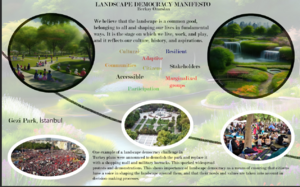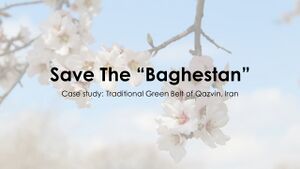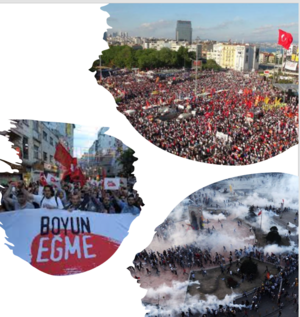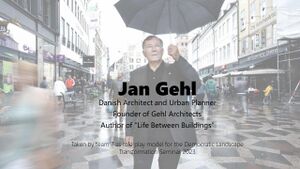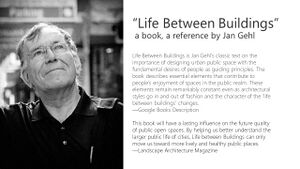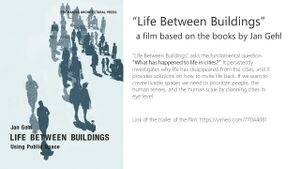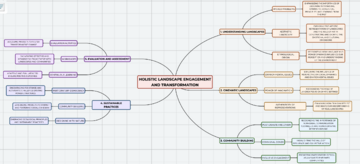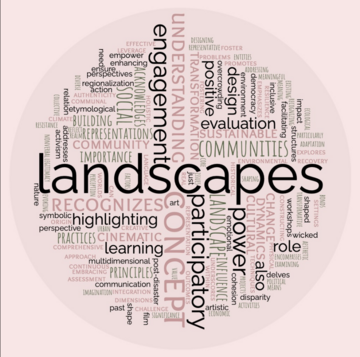Democratic Landscape Transformation 2023 - Team 7
>>> Back to working group overview
>>> Back to seminar reading list
The Team
- Berkay Özarslan: I graduated from Ege University in Turkey with title 'Landscape Architect' in 2022 and I wanted to develop this profession further more with master degree, During my university year I attended several design workshops voluntarily. I had a chance to study in SGGW, Warsaw for 1 semester with Erasmus Programme. My aim in my professional life is to make sustainable Landscape designs that inspires people.
- M. A. A.: I am an Urban Planner, and currently pursuing a master's in Landscape Architecture.
- Ansam Bzour: A Ph.D. student in Landscape Protection and Reclamation at the Hungarian University of Agriculture and Life Sciences. I have a master degree in landscape architecture and I am a licensed architect. Currently I am working as a landscape architect and plant designer for private villas backyards in Jordan and at the same time, I teach master students of landscape architecture. Specialised in landscape theory and practice, site and system analysis.
Landscape Democracy Manifestoes
Here you can add links to the manifestoes you have presented on April 26
- Ansam Bzour: https://docs.google.com/presentation/d/1VXegVuBjH8LOFaTcZkVdaw4wdDrMZBMwlZHZzALPgyE/edit#slide=id.p
- Berkay Özarslan,Manifesto, Gezi Park, İstanbul. Link: https://drive.google.com/file/d/1vliiu2ldQ99OPiQNjdCwKV_hOUQo9oWy/view?usp=share_link
- M. A. A.: https://uploadnow.io/f/CH5q31J
Examples of Landscape Activism
Berkay Özarslan, 'İstanbul Not for Sale' Movement
During a period of rapid urban development and gentrification in Turkey, early 2013s, . Many historic neighborhoods and green spaces in the city were being demolished. The government had announced plans to demolish the Gezi Park in Taksim Square and replace it with a shopping mall, which sparked a wave of protests across the country. The activists saw this as a threat to the democratic rights of citizens to participate in decision-making processes that impact their lives and their environment. •The movement was led by young designers who used their creative skills to mobilize support and raise awareness about the importance of preserving public spaces and green areas in the city. •The Istanbul Not For Sale campaign worked with urban planners and architects to develop alternative models of urban development that were more participatory and sustainable. They organized workshops and public forums where residents could share their ideas and concerns about the future of their neighborhoods •Through their efforts, the Istanbul Not For Sale campaign succeeded in raising awareness about the negative impacts of urban development and promoting alternative models of urban planning that were more participatory, sustainable, and equitable.
Link to the presentation :https://docs.google.com/presentation/d/e/2PACX-1vTudKq3v8c_pyCXWw7qKY_oIG3saTxurhjN4xrOLAT8gxL_nmF-Rz6cBT4V-GLa98oDzt9YNrp9nsuT/pub?start=false&loop=false&delayms=3000
Ansam Bzour: Greening the Camps project Zaatari Camp - Jordan
https://docs.google.com/presentation/d/1VXegVuBjH8LOFaTcZkVdaw4wdDrMZBMwlZHZzALPgyE/edit#slide=id.p
The Role Play
Jan Gehl
Danish Architect and Urban Planner
Founder of Gehl Architects
Author of “Life Between Buildings”
Taken by team 7 as role play model for the Democratic Landscape Transformation Seminar 2023
Life Between Buildings is Jan Gehl's classic text on the importance of designing urban public space with the fundamental desires of people as guiding principles. The book describes essential elements that contribute to people's enjoyment of spaces in the public realm. These elements remain remarkably constant even as architectural styles go in and out of fashion and the character of the 'life between buildings' changes. "Google Books Description"
This book will have a lasting influence on the future quality of public open spaces. By helping us better understand the larger public life of cities, Life between Buildings can only move us toward more lively and healthy public places. "Landscape Architecture Magazine"
“Life Between Buildings” asks the fundamental question “What has happened to life in cities?”. It persistently investigates why life has disappeared from the cities, and it provides solutions on how to invite life back. If we want to create livable spaces we need to prioritize people, the human senses, and the human scale by planning cities in eye level.
Readings, concepts and definitions
- Start: April 5, 2023
- Due: July 5, 2023
Working in your group, express your personal understanding of the relation of landscape and democracy in the form of a concept map with linking words or any other diagrammatic representation. Please make your maps very visual and not just verbal. Think critically about why one map differs from another
About concept mapping
Before starting the exercise you can read this article by Joseph D. Novak & Alberto J. Cañas about Theory Underlying Concept Maps and How to Construct and Use Them. This paper gives a good explanation of how concept maps are conceived and developed.
You can use any tool you like for producing your concept map. However, since the result needs to be submitted digitally we recommend the following open source software for producing your maps:
- Cmap Tools >>> you can also work with your group on the Cmap cloud doing a shared map
- VUE - The Visual Understanding Environment
Concept Map
- Possible format: JPG (for wiki upload) or link to any other resource
- You may add one map per team member or an integrated one add as many additional materials as you need
- https://docs.google.com/presentation/d/11TqIvJLoSlWIC9G-BYJHErPVVE6kBsmUlpMlh9ucY0k/edit#slide=id.g257486556c1_0_609
- "Holistic Landscape Engagement and Transformation." It encompasses a multidimensional approach to understanding, shaping, and enhancing landscapes and communities through the integration of diverse perspectives, participatory practices, creative design, and sustainable principles. At its core, this concept recognizes that landscapes are not just physical entities, but also symbolic worlds of meaning shaped by historical, cultural, and social factors. It acknowledges the etymological origin and political regionalization of landscape, highlighting how language and power dynamics influence our perception and understanding of the environment. It explores the aesthetic landscape and artistic representation, recognizing the role of art in constructing and evoking the emotional and cultural dimensions of landscapes. In addressing wicked problems, such as urban overcrowding, climate change, and economic disparity, this concept emphasizes the importance of designing with nature, embracing ecological principles, and learning from the past. It underscores the significance of sustainable practices, community building, and participatory democracy in fostering legitimacy, social cohesion, and positive transformation. Within the realm of cinematic landscapes, this concept delves into the authenticity of representations, the power of imagination, and the influence of perspective. It recognizes the role of landscapes as cinematic settings, while also examining how film can reflect and shape our understanding of real landscapes, particularly in relation to environmental issues and social dynamics. This concept addresses community building, communal bonds, and post-disaster recovery, highlighting the value of inclusive engagement, resilience, and collective action. It promotes participatory design as a means to empower communities, leverage projects for impact, and foster resistance and activism to challenge existing power structures. This comprehensive concept acknowledges the importance of nonverbal communication techniques, representative representations, workshops, and evaluation and assessment activities in facilitating effective and meaningful engagement with landscapes and communities. It recognizes the need for continuous learning, adaptation, and evaluation to ensure positive outcomes and transformative change.
Reflection
- What are the similarities and differences in your team regarding your understanding of what democratic landscape transformation is? The team has diverse perspectives on democratic landscape transformation. All of us were benifiting from earning and experimenting throughout the project. The different understanding have led to explore and refine through their collective experiences. In a diverse team working on democratic landscape transformation, there are both similarities and differences in our understanding of the concept. The team members share a recognition of the importance of democracy, emphasizing the central role of democratic principles and processes in landscape transformation. We also agree on the significance of community engagement, valuing the participation and knowledge of local communities. Additionally, we share a focus on sustainability and resilience, acknowledging the need to address environmental challenges and promote long-term ecological and social well-being. However, differences arise in the interpretation of democracy, with team members emphasizing different aspects such as equitable decision-making or inclusive processes. We may also prioritize different values, such as social justice, equity, sustainability, or cultural heritage preservation, leading to varying emphases within the team. Furthermore, We may have divergent approaches to implementation, with some advocating for top-down policy changes and institutional reforms, while some of us prefer grassroots initiatives and community-led projects. These differences in interpretation, values, and approaches stem from individual experiences, disciplinary backgrounds, and personal philosophies within the diverse team.
- In how far did the seminar lectures and readings help you to clarify this? The seminar lectures and readings have played a significant role in helping our team clarify their understanding of democratic landscape transformation. By engaging with presentations, discussions, and multimedia resources from around the world, the instructors would have had the opportunity to explore different theoretical frameworks, practices, and case studies related to landscape democracy. This exposure to diverse perspectives and knowledge have contributed to a deeper understanding of the concept and its various dimensions.
- What will you take home from this seminar? We have gained insights into effective techniques for community engagement and participation, learned about different power structures influencing landscape transformations, and expanded our understanding of key principles such as empathy, sustainability, resilience, and justice in the context of landscapes. They have also developed a systems thinking mindset and acquired practical skills like landscape storytelling and mapping, which can be valuable in promoting democratic landscape transformations. Ultimately, the specific takeaways would vary for each member of the team based on our individual interests, prior knowledge, and engagement with the seminar materials.
